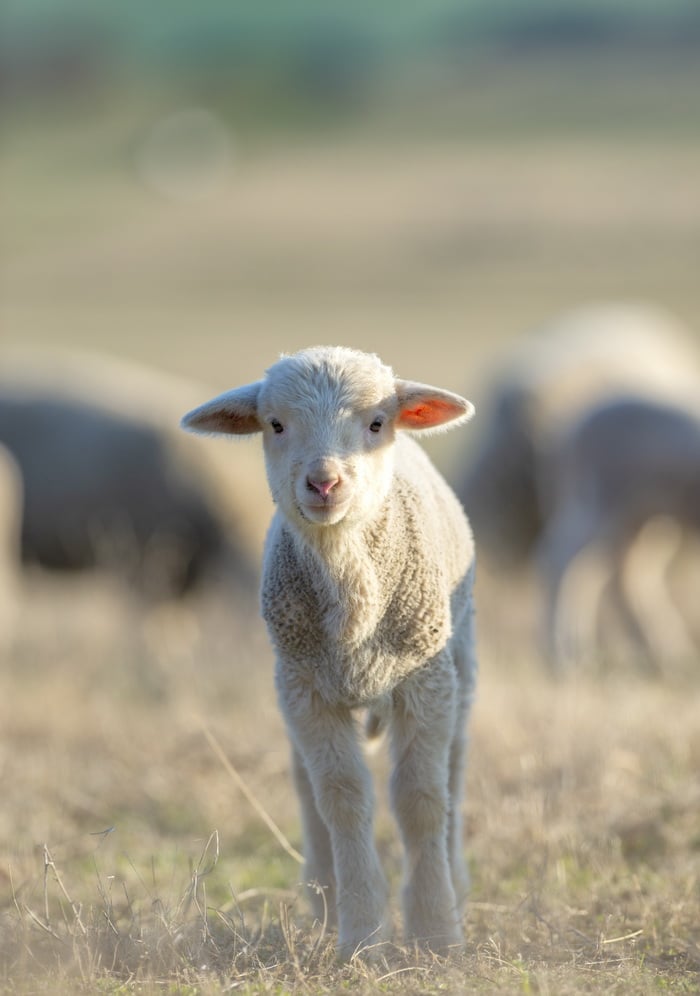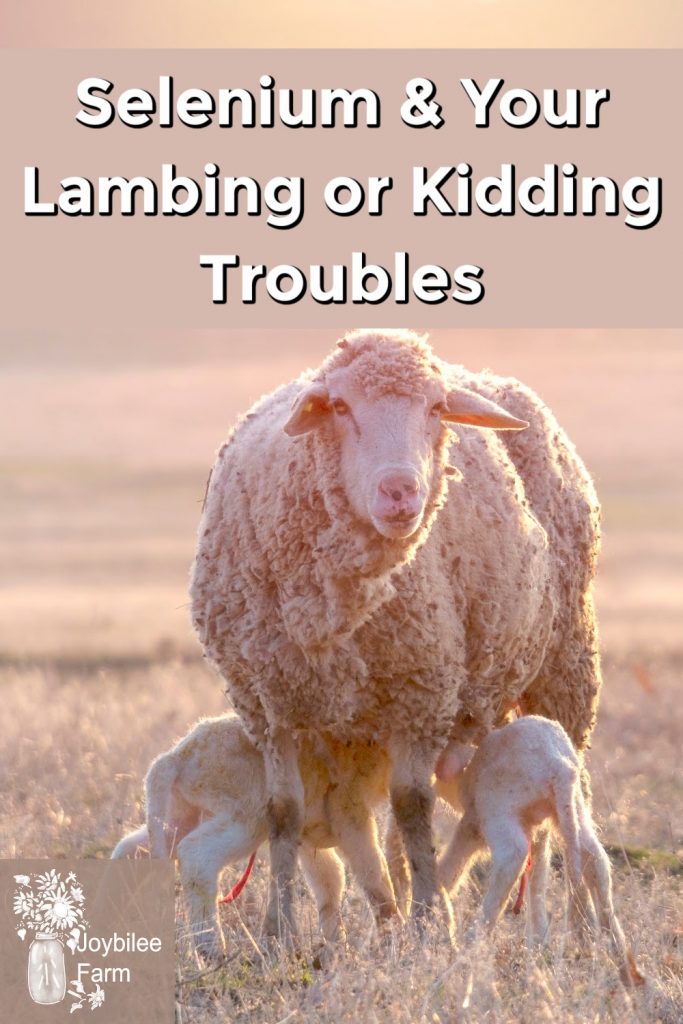Selenium deficiency: a matter of life and death in your flock
If you are having lambing problems this Spring, selenium deficiency in lambs may be the issue. Know when to supplement.
Selenium and your lambing/kidding troubles
Selenium is essential for life. Selenium is needed for thyroid function and the removal of toxins from the body. Even humans with low selenium struggle with joint problems – most often arthritis in the knees. In livestock selenium also presents problems with movement. In fact, your sheep, goats, and cattle are going to have birthing problems and your babies are going to struggle if you don’t have enough of it in your animal feed and your soil.
Selenium is missing in many of the soils in North America and around the world. If you don’t have it in the soil, it won’t be in the forage, hay, and grain that you’re feeding your livestock. Your animals will be deficient. You will need to supplement.
Selenium affects the oxygen supply to the muscles. Oxygen-deprived muscles are weaker and less elastic. Lambs with severe selenium deficiency are diagnosed with “white muscle disease” – revealing that the muscle tissue lacks a strong oxygenated blood supply when selenium is an issue.
Selenium works in tandem with vitamin E – the sex vitamin. Vitamin E is essential in all phases of reproduction, so you can see why Selenium and vitamin E deficiency will show up at lambing time.
Animals as well as humans need selenium, a trace mineral and component of antioxidants, to stay healthy. Inadequate selenium in sheep reduces conception rates, increases neonatal mortality, and in some instances, causes “white muscle disease”-nutritional muscular dystrophy. Selenium deficiency in sheep and cattle costs livestock producers an estimated $545 million annually in losses and affects livestock in more than 35 states where regions are deficient in the mineral. – USDA
Selenium Deficiency during the birth
While selenium deficiency affects the growing fetus and can cause birth defects, often the shepherd’s first inclination that there is a problem is in the spring. Selenium deficiency shows up when your females go into labour. The babies are weak and their muscle tone is flaccid, so birth presentation is poor. Babies present in the birth canal with a leg turned back, or a head turned back. Or worse a selenium-deficient baby will fail to move into the birth canal at the proper time. You’ll see the ewe straining and only fluid gushing out. If you feel around inside you may find the baby in a breech position or even its side presented for delivery. Selenium deficient ewes produce weakened lambs. The weakened lambs don’t move into the right position for easy delivery – two front feet forward and a nose. Instead, they malpresent with their weakened muscles, and this is when you, as a shepherd, might notice the deficiency. One malpresentation doesn’t mean there’s a problem with selenium, but if you have several, try giving an injection to the ewes one month before you expect to lamb.
Selenium deficiency at birth
After birth the problems compound. Selenium deficient babies might be too weak to stand on delivery. They may hold their head to the side. And their tongue may be uncoordinated so that their suck isn’t efficient. Their slack muscle tone can show up as droopy ears, a congested breath with lungs that don’t clear completely during the birth process. In severe cases of selenium deficiency, even correcting with injectable selenium won’t help. Severe deficiency causes permanent birth defects and even death in the womb. However, mild but life-threatening deficiency can be corrected with a treatment dose of injectable selenium-vitamin E, given subQ, to the newborn. Oral supplementation is ineffective in the newborn, so please have injectable selenium/vitamin E on hand if you know your area is deficient.
Selenium deficiency and the after-birth
Ewes that are low in selenium may have weaker contractions than normal ewes. This can result in a longer, more exhausting labour. Further, the placenta may fail to deliver. This can often be corrected in minutes with a dose of selenium after birth. Don’t inject with selenium if the ewe had selenium within the last 30 days, as it is possible to overdose with selenium. I’ve seen the placenta delivered in 30 minutes of the ewe receiving a selenium injection.
How do you know if your homestead is deficient in selenium?
Your local feed store or agricultural extension office can tell you if your region is deficient. Soils west of the Rocky Mountains in North America are generally deficient in selenium. Usually, rainy areas are also deficient as soil salts leach out in heavy rains. Dry belt areas can have high selenium, though, as there is a native plant that is high in selenium that grows in drier regions.

Why loose mineral that contains selenium may not offer an adequate supply.
Commercial feed is generally formulated with added selenium. If your area is deficient in selenium this will not offer an adequate supply for your livestock. Further, offering a loose mineral that is high in selenium might not give an adequate supply to your females to alleviate the trouble. Male animals are usually able to thrive given these two sources of supplementation, even in areas that are low in selenium. However, individual animals metabolize selenium at different rates.
During pregnancy and birth, stores of selenium are rapidly depleted by the growing fetus. Mothers carrying twins or triplets are more likely to have deficiencies than animals carrying a single lamb. Ask your vet if you are in doubt about what to do in your specific circumstance.
When you should increase your supplementation protocol:
Consider supplementing your flock routinely if you find yourself facing the kinds of birthing problems that I mentioned above:
Lambs mispresenting in the birth canal
Prolonged labour
Lambs weak and not standing at birth
Shaky, wobbly lambs
Lambs without strong suck reflex
Retained placenta
Selenium and vitamin E
Selenium is given in conjunction with vitamin E. Animals that are low in vitamin E will present with the same symptoms as selenium deficiency, so these two are always given together in one injection. Animals that are on dry rations of hay and grain alone, often present with symptoms similar to selenium deficiency, but are actually deficient in vitamin E. To differentiate between these two a postmortem tissue sample is necessary. Adding black oil sunflower seeds to the diet of your livestock can increase the available vitamin E.
How and when to supplement with selenium
When dosing sheep with selenium, keep these points in mind.
•Always read the label to determine theconcentration of selenium. Dosing must beaccurate: there is little room for error.•When treating adult sheep, take care to ensurethat the adult dose is given. The dose inclostridial vaccines is sufficient for lambs, but notfor ewes.•Selenium pellets cannot be given to lambs under12 weeks of age. The pellet will not stay in theanimal until the rumen is developed.•Selenium pellets should be used on propertieswhere selenium–responsive ill thrift or infertilityhas been diagnosed. They will provide adequatelevels of selenium for longer periods than othermethods of prevention.•Selenium pellets will provide protection for 15 to36 months; selenium incorporated in drenchesand vaccines will provide adequate seleniumlevels for about 8 weeks.Selenium Deficiency in Sheep, New South Wales, Department of Primary Industries (downloadable pdf)
It is possible to have selenium toxicity when you are adding selenium to the diet of your ewes. Many of the symptoms of selenium toxicity are similar to the symptoms of selenium deficiency. Note that injected selenium gives adequate selenium for only 2 months. So if you inject your ewes before breeding, you will need to give another dose of selenium no later than 4 weeks before birth, to ensure that adequate stores of selenium remain for birthing time. Always consult your veterinarian for specific recommendations for your personal needs.
Symptoms of selenium toxicity:
•respiratory distress•restlessness•blindness•staggering•head pressing•anorexia•salivation•abdominal pain•watery diarrhoea•convulsions•paralysis, and•death.If you suspect selenium toxicity, seek veterinaryadvice immediately. Treatment may be attempted,however the prognosis is guarded. (Selenium Deficiency in Sheep, New South Wales, Department of Primary Industries)
Monday Menagerie blog hop
Bloggers, please link up your posts related to animal husbandry, pictures of your lambs, chicks, goat-kids, or calves, and anything related to raising animals on your homestead.




Leave a Reply